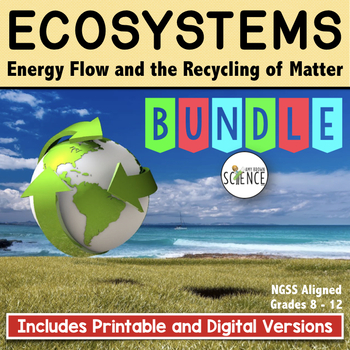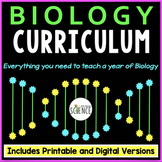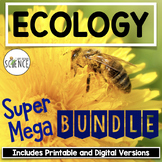Ecosystems Unit Bundle - Energy Flow, Food Chains, Matter Recycling
- Zip
- Google Apps™

Products in this Bundle (9)
showing 1-5 of 9 products
Bonus
Also included in
- This NO PREP, PRINTABLE, EDITABLE, AND DIGITAL Biology Curriculum contains everything you need for an entire year of Biology! For less than $3 a day, you can save your time, energy, and sanity. Each of the 20 Complete Units includes a teaching PowerPoint presentation, notes, labs, homework assignmenPrice $525.00Original Price $988.18Save $463.18
- All of my ecology and environmental science resources (6 ecology unit bundles) are included in this one Super-Mega-Bundle! This mega-bundle includes all of the PowerPoints, notes, labs, task cards, homework assignments, review games, quizzes, activities, and unit tests that you need to teach a compPrice $178.00Original Price $252.64Save $74.64
Description
This "Ecosystems Complete Unit Bundle" covers the flow of energy through ecosystems, the recycling of matter, food chains and food webs, energy pyramids, biogeochemical cycles, and more. See complete list of topics covered below.
This unit bundle includes everything you need to teach a unit on ecosystems, energy flow and the recycling of matter to your life science or biology students. The bundle contains an 83-slide PowerPoint presentation, lecture notes for the teacher, a guided notes outline for the students, a set of 107 task cards, crossword puzzle, set of 5 homework assignments, set of 5 quizzes, an outdoor lab activity, my Food Chains/Food Webs activity, a test prep/review question PowerPoint and a final unit test.
From the engaging PowerPoint to the final unit test, this bundle contains loads of NO PREP materials that are ready to be used with your students. All resources are printable (editable) and many of the resources in this bundle are available in paperless digital formats (Google Slides and Google Forms) for use in Google Drive, Google Classroom, Microsoft OneDrive, or similar.
What is included in this bundle? ( Items marked with ** have both printable and digital versions.)
- Ecosystems and the Biosphere: Energy Flow and the Recycling of Matter PowerPoint with Notes for Teacher and Student **
- Food Chains and Food Webs Activity **
- Lab Activity: Exploring an Ecosystem **
- Ecosystems Task Cards **
- Ecosystems Homework Bundle of 5 Assignments **
- Ecosystems - Energy Flow and the Recycling of Matter Quiz Bundle **
- Ecosystems Crossword Puzzle
- Energy Flow and the Recycling of Matter Review Questions and Answers
- Ecosystems Unit Test **
A Teacher Guide containing tips for implementing the resources, suggestions for sequencing, and alignment to NGSS standards is also included.
I have included each product in an editable format, and I have also included each product in PDF form.
Complete teacher guides and teacher answer keys are included for each resource.
Topics covered in this Bundle:
- Energy Flow Through the Ecosystem: Sunlight as a source of energy, importance of photosynthesis, conversion of energy into glucose and other organic compounds.
- Autotrophs, producers, examples of autotrophs, chemoautotrophs and chemosynthesis.
- Heterotrophs, consumers, examples of heterotrophs, herbivores, carnivores, omnivores, detritivores, decomposers, the essential nature of decomposition.
- Feeding Relationships: One way flow of energy through the ecosystem, food chains, examples of food chains, food webs, trophic levels, primary producers, primary consumers, secondary consumers, tertiary consumers.
- Productivity of the Ecosystem: Two ways to measure productivity, gross primary productivity, the role of glucose in productivity, biomass, net primary productivity, factors that determine productivity in both terrestrial and aquatic ecosystems.
- Energy transfer between trophic levels, ecological pyramids, percentage of energy that moves up to the next trophic level, reasons why the transfer of energy is so low.
- Given a hypothetical food chain, the student will identify the autotroph, the primary consumer, secondary consumer, and tertiary consumer as well as calculate the amount of energy passed to each trophic level.
- Ecosystem recycling: the recycling of matter, the essential need to recycle carbon, nitrogen, water, and phosphorus, biogeochemical cycles.
- Water Cycle: Location of water, evaporation, precipitation, transpiration, condensation, steps to water cycle, students will complete a diagram of the water cycle.
- The Carbon Cycle: The importance of carbon to organic compounds, the role of photosynthesis and cellular respiration in the carbon cycle, the role of erosion and volcanic activity in the carbon cycle, decomposition, burning of fossil fuels, steps to the carbon cycle, the student will label a diagram of the carbon cycle, the human impact on the carbon cycle.
- The Nitrogen Cycle: The importance of nitrogen in building proteins and nucleic acids, nitrogen fixation, ammonification, nitrification, denitrification, assimilation, the role of various bacteria in the nitrogen cycle, students will label a diagram of the nitrogen cycle.
- The Phosphorus Cycle: The importance of phosphorus to ATP and nucleotides, the movement of phosphorus through the ecosystem.
- Limiting nutrients
The PowerPoint consists of 83 slides that are colorful, informative and visually stimulating. Pictures and diagrams are included that will greatly enhance your instruction to your students. This product also includes a set of notes for the teacher and a set of notes for the student. The students get an outline of the notes that they fill in as the PowerPoint lesson is being presented.
This teaching bundle is appropriate for all biology students in grades 8 - 12.
Related Products Include:
Introduction to Ecology Complete Unit Bundle
Population Ecology Complete Unit Bundle
Community Ecology Complete Unit Bundle
For updates about sales and new products, please follow my store:
I would love to have you follow me at these locations as well:
My Blog: Amy Brown Science.com
Instagram: @AmyBrownScience







